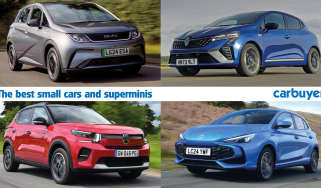New 2020 Honda Jazz hybrid: prices, specs and release date
Next-gen Honda Jazz hatchback will be hybrid only and return 62.8mpg
- Honda reveals prices and performance specifications for new Jazz hybrid
- Jazz retains ‘Magic Seats’ and impressive practicality
- Available to order now
The new, fourth-generation Honda Jazz has a starting price of £18,980. Four trim levels called SE, SR, EX and Crosstar EX are available, with the range-topper costing £23,580 before options. The hybrid-only Honda Jazz can be ordered now, with deliveries expected to start in the next couple of months.
Full specs are yet to be revealed but the top-spec Crosstar EX model is likely to get leather upholstery, while most models will benefit from a new LCD touchscreen offering wireless Apple CarPlay and Android Auto. A Wi-Fi hotspot will also be available. The more rugged-looking ‘Crosstar’ version will compete with the Ford Fiesta Active.
The best superminis you can buy
Honda has confirmed that the entry-level SE will cost from £225 per month on a 36-month PCP finance agreement, after a 20% customer deposit. Crystal Black will be the default paint choice, but you can choose from a number of other shades costing £550 or £650.
2020 Honda Jazz engines, MPG and performance
A Jazz hybrid has previously been available but, for this new model, there’s no other option. A 1.5-litre petrol engine is mated to two compact electric motors and a small battery, and in total the system produces 108bhp. That may not sound like much, but the Jazz can accelerate from 0-62mph in a very respectable 9.4 seconds and on to a top speed of 108mph.
You don’t have to plug the Jazz in to recharge the battery and the electrical assistance mainly works to boost fuel economy. Honda says you can expect up to 62.8mpg from the standard model and 58.9mpg from the jacked-up Crosstar. Three driving modes are present, letting you choose whether the car runs on petrol, electric or both.
Like most hybrids, the Jazz is automatic-only, but it does away with a traditional gearbox. There’s a single fixed-gear ratio like you get in an electric car, which is smaller than the company’s CVT gearbox and promises smooth acceleration.
Styling
The fourth-generation Honda Jazz will retain its tall, mini-MPV looks. The front end includes new headlights with LED elements and a blanked-off grille panel, highlighting the hybrid powertrain. Underneath, the front bumper will get slightly different air vent designs depending on the trim level, while the rear end has been similarly redesigned. A pseudo-SUV style Crosstar version will be offered for the first time, with black plastic body cladding, a black roof, a proper grille and silver roof rails.
Interior
The interior of the Jazz has been revised with a large sweep of coloured material across the dashboard. The design of the centre console is clean and minimalist, while it appears that the Jazz will get a new two-spoke steering wheel similar to the one in the Honda e. Behind the wheel, a digital instrument cluster is expected to be fitted as standard.
Honda has fitted new seats with extra cushioning, to prevent aches on long journeys, while a central armrest is a welcome addition. We’re told the window pillars are much slimmer than before, helping to improve visibility.
Practicality
Practicality will be improved in the new model. A slight increase in dimensions improves passenger and boot space, making the new Jazz one of the most spacious superminis on the market. Like previous cars, Honda’s ‘Magic Seat’ system will be fitted, meaning the rear seats can slide forwards and backwards, and the seat bases fold up like cinema seats if you need to carry tall or bulky items.
Boot space stands at 298 litres with the seats in place (about the same as a Ford Fiesta and Nissan Micra), or 1,203 litres with the rear seats folded. The hybrid system takes up space under the boot floor, as the outgoing model offers 354 and 1,314 litres respectively.
Safety
Improvements to the Honda Sensing package means the Jazz should be safer than ever. Its high-definition camera offers better perception of roadside markings and soft verges, while the autonomous emergency braking (called Collision Mitigation Brake System, or CMBS) has a more advanced night-time function with pedestrian and cyclist detection. Adaptive cruise control and lane-keeping assist are available, and the latter works on urban and rural roads as well as motorways.
The new Peugeot 208 will be a major rival to the updated Jazz - read all about it here, and check out our list of the best reliable small cars you can buy in 2020.
Recommended

Top 10 used hatchbacks – the best second-hand buys in 2025
Most Popular
Tips & advice

Car dashboard warning lights: what does each symbol mean?

Electric car charging stations: public networks, charger types, apps and maps













